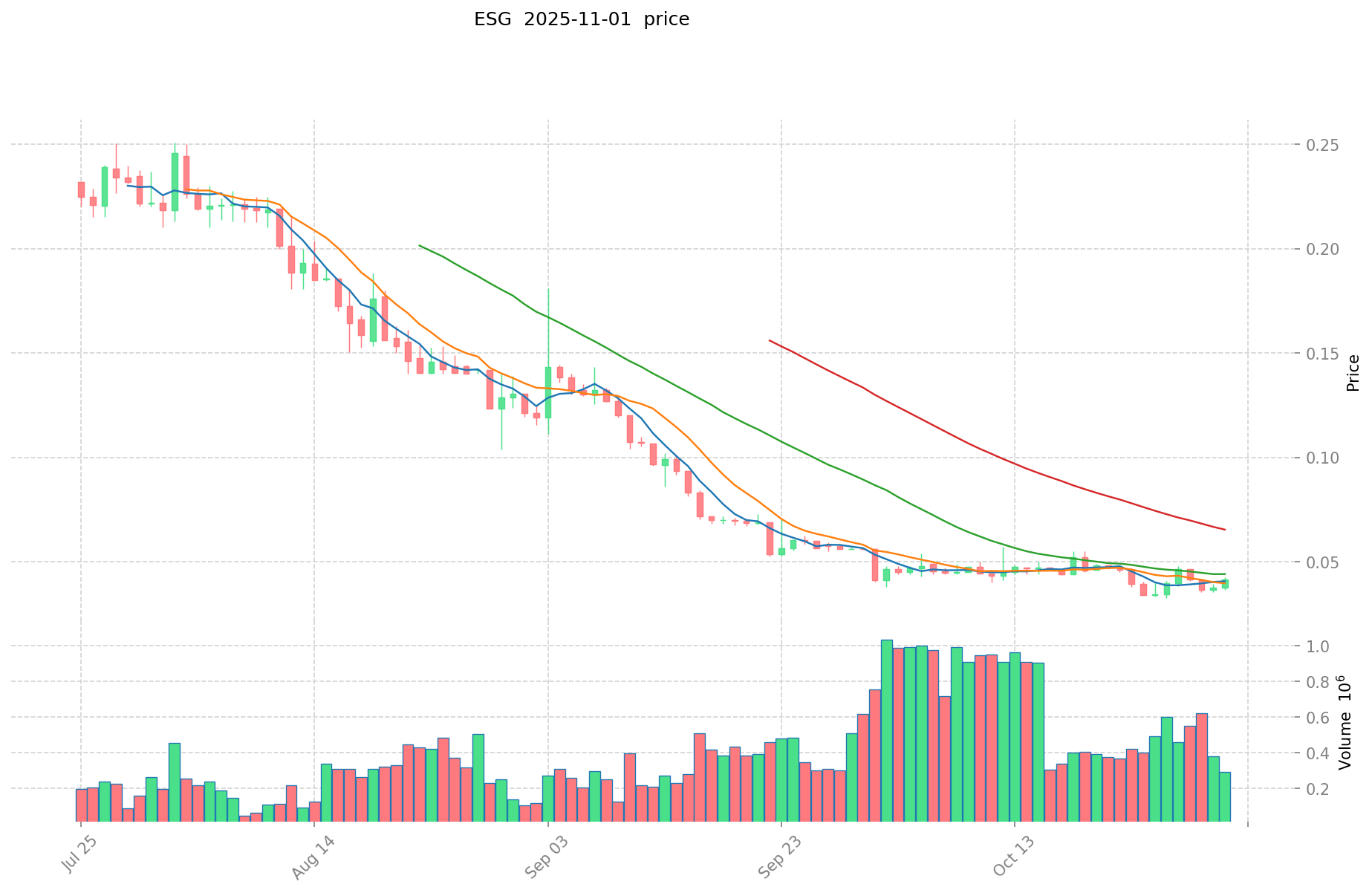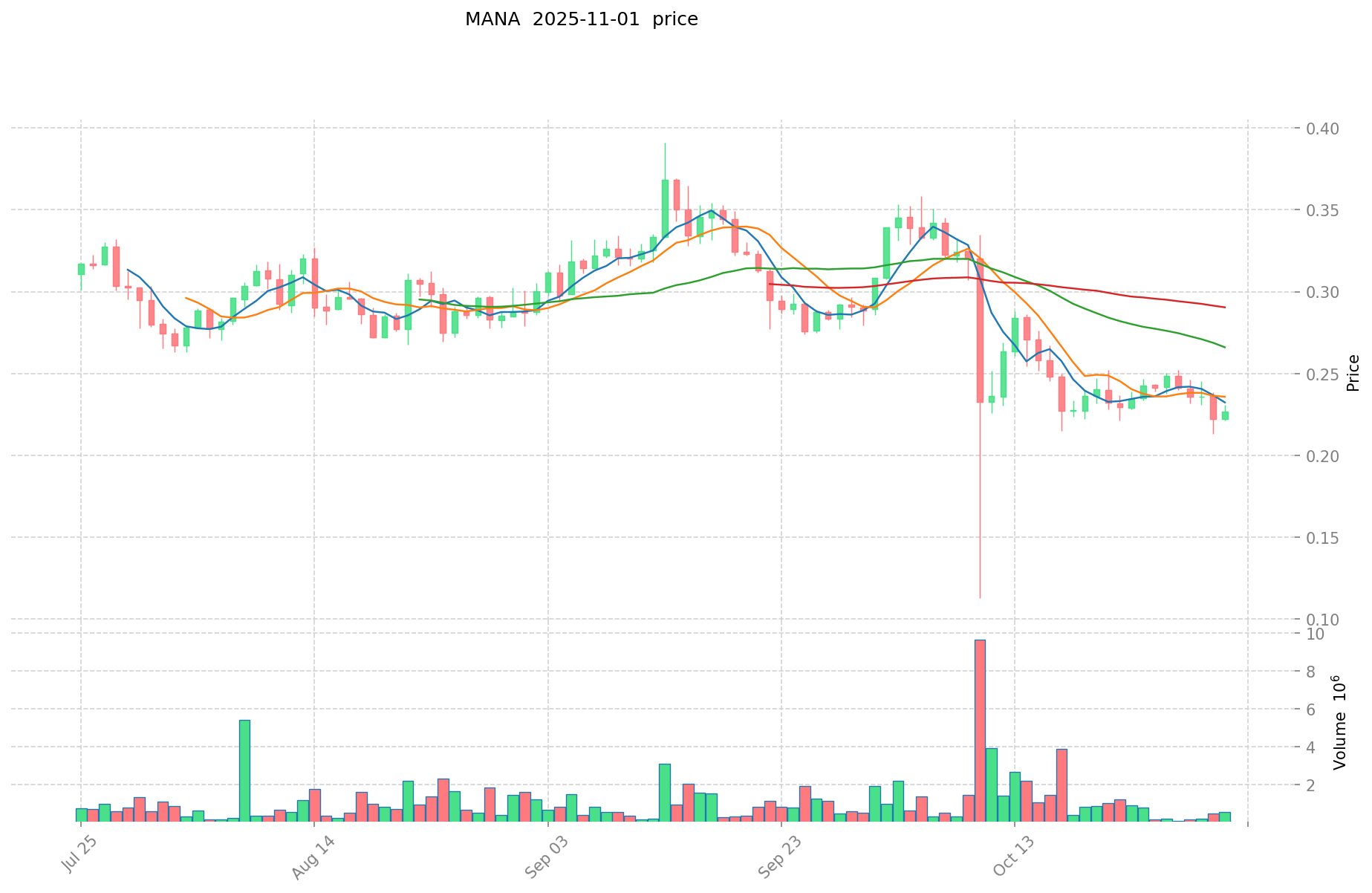ESG vs MANA: Comparing Sustainability and Virtual Reality Investments in the Digital Age
Introduction: Investment Comparison of ESG vs MANA
In the cryptocurrency market, the comparison between ESG vs MANA has always been a topic that investors can't ignore. The two not only have significant differences in market cap ranking, application scenarios, and price performance, but also represent different positioning in crypto assets.
ESG (ESG): Since its launch, it has gained market recognition for its focus on voluntary carbon reduction applications.
Decentraland (MANA): Since 2017, it has been hailed as a blockchain-based virtual world platform, and is one of the cryptocurrencies with the highest global trading volume and market capitalization.
This article will comprehensively analyze the investment value comparison between ESG vs MANA, focusing on historical price trends, supply mechanisms, institutional adoption, technological ecosystems, and future predictions, and attempt to answer the question that investors care about most:
"Which is the better buy right now?"
I. Price History Comparison and Current Market Status
ESG (Coin A) and MANA (Coin B) Historical Price Trends
- 2021: MANA price surged to an all-time high of $5.85 due to the metaverse hype.
- 2022: ESG launched its token with an initial price of $1.0.
- Comparative analysis: During the 2022 bear market, MANA dropped from its peak of $5.85 to under $1, while ESG also experienced significant decline from its launch price.
Current Market Situation (2025-11-01)
- ESG current price: $0.03893
- MANA current price: $0.2319
- 24-hour trading volume: ESG $12,247.65813 vs MANA $140,294.000671
- Market Sentiment Index (Fear & Greed Index): 33 (Fear)
Click to view real-time prices:
- Check ESG current price Market Price
- Check MANA current price Market Price
II. Project Fundamentals Analysis
ESG (Coin A)
Project Overview
ESG Finance has expanded its business domain from a Renewable Energy NFT Platform to the Voluntary Carbon Reduction sector. The project aims to become the leading developer of applications for voluntary carbon reduction, focusing on securing emission rights for individual carbon reduction efforts through an objective reward system.
Key Features
- Renewable Energy NFT Platform
- Voluntary Carbon Reduction applications
- Objective reward system for individual carbon reduction
Recent Developments
- Expansion into the Voluntary Carbon Reduction domain as outlined in Whitepaper 2.0
MANA (Coin B)
Project Overview
Decentraland is a blockchain-based virtual world platform that allows users to create, experience, and monetize content and applications. It uses MANA as its native token for transactions within the virtual world.
Key Features
- Virtual land ownership (LAND tokens)
- User-created content and experiences
- Decentralized marketplace for virtual assets
Recent Developments
- Continued development of the virtual world and integration with various Web3 technologies
III. Technical Analysis
ESG (Coin A)
- Current price: $0.03893
- 24h price change: -5.44%
- 7d price change: +10.44%
- Trading volume (24h): $12,247.65813
MANA (Coin B)
- Current price: $0.2319
- 24h price change: +0.34%
- 7d price change: -4.63%
- Trading volume (24h): $140,294.000671
Technical Indicators
- ESG is showing a short-term uptrend despite recent volatility
- MANA is experiencing a downtrend in the medium term but shows signs of stabilization
IV. Investment Risks
- Market volatility: Both tokens have shown significant price fluctuations
- Regulatory uncertainties: Potential changes in cryptocurrency regulations could impact both projects
- Project-specific risks:
- ESG: Relatively new project with unproven long-term viability
- MANA: Dependence on the growth and adoption of the virtual world concept
V. Future Outlook
- ESG: Potential growth in the carbon reduction and renewable energy sectors could drive adoption
- MANA: The development of metaverse technologies and increased interest in virtual worlds may support long-term growth
VI. Conclusion
Both ESG and MANA represent innovative projects in their respective fields. While ESG focuses on sustainability and carbon reduction, MANA is at the forefront of virtual world development. Investors should carefully consider the potential risks and rewards associated with each project, as well as their own investment goals and risk tolerance.


ESG Investment Value Analysis: Core Factors
I. The Core Factors of ESG Investment Value
Environmental, Social, and Governance (ESG)
ESG is an acronym representing three core factors used to evaluate companies' sustainable investment value:
- Environmental: Climate change impact, carbon emissions, pollution, resource usage, waste management, renewable energy adoption
- Social: Labor standards, safety protocols, consumer protection, community relations, human rights
- Governance: Corporate structure, ethics, transparency, shareholder rights, executive compensation
Value Creation and Performance
Research consistently shows that companies with high ESG ratings tend to:
- Demonstrate better financial performance
- Experience lower volatility and systemic risk (lower beta coefficient)
- Enjoy reduced capital costs
- Exhibit enhanced innovation and operational performance
Four Key Value Drivers
- Market Expansion: Strong ESG practices build trust with consumers and business partners, opening access to new markets
- Consumer Preference Alignment: Modern consumers increasingly prefer environmentally responsible products and services
- Cost Reduction: Efficient resource usage and improved operational processes lead to significant savings
- Employee Productivity: Strong ESG values create greater employee engagement and mission-driven performance
II. The Evolution of ESG Investment
Historical Development
- 1960s-70s: Early roots in socially responsible investing (SRI)
- 1971: First social responsibility investment fund established
- 1990: First social responsibility investment index created
- 2004: ESG concept formally introduced in UN-backed "Who Cares Wins" report
- Present: Mainstream investment approach with growing regulatory support
ESG vs. SRI Comparison
"ESG is sustainable investing 2.0 - thoughtfully and consciously incorporating ESG funds into investment plans not only because they benefit society and the planet, but because they deliver uncompromised financial returns."
Measurement and Standards
- No universal standard exists, though frameworks like GRI (Global Reporting Initiative) are widely adopted
- Rating agencies like MSCI evaluate companies across seven performance grades (CCC to AAA)
- Assessment based on peer comparison, company disclosures, and independent data sources
Regulatory Landscape
- Hong Kong: Mandatory ESG reporting requirements for listed companies
- China: Encouraging disclosure with plans for mandatory requirements
- Global: Increasing regulatory emphasis on supply chain management and transparent ESG reporting
III. 2025-2030 Price Prediction: ESG vs MANA
Short-term Prediction (2025)
- ESG: Conservative $0.035308 - $0.0388 | Optimistic $0.0388 - $0.039964
- MANA: Conservative $0.153384 - $0.2324 | Optimistic $0.2324 - $0.343952
Mid-term Prediction (2027)
- ESG may enter a growth phase, with an estimated price range of $0.0338133852 - $0.0475892088
- MANA may enter a bullish phase, with an estimated price range of $0.2259011664 - $0.4248290592
- Key drivers: Institutional capital inflow, ETF, ecosystem development
Long-term Prediction (2030)
- ESG: Base scenario $0.0565485035304 - $0.079733389977864 | Optimistic scenario $0.079733389977864+
- MANA: Base scenario $0.45856857848256 - $0.536525236824595 | Optimistic scenario $0.536525236824595+
Disclaimer: The above predictions are based on historical data and market trends. Cryptocurrency markets are highly volatile and subject to rapid changes. These forecasts should not be considered as financial advice. Always conduct your own research before making investment decisions.
ESG:
| 年份 | 预测最高价 | 预测平均价格 | 预测最低价 | 涨跌幅 |
|---|---|---|---|---|
| 2025 | 0.039964 | 0.0388 | 0.035308 | 0 |
| 2026 | 0.04410784 | 0.039382 | 0.0216601 | 1 |
| 2027 | 0.0475892088 | 0.04174492 | 0.0338133852 | 7 |
| 2028 | 0.049580441484 | 0.0446670644 | 0.031713615724 | 14 |
| 2029 | 0.0659732541188 | 0.047123752942 | 0.02403311400042 | 21 |
| 2030 | 0.079733389977864 | 0.0565485035304 | 0.029405221835808 | 45 |
MANA:
| 年份 | 预测最高价 | 预测平均价格 | 预测最低价 | 涨跌幅 |
|---|---|---|---|---|
| 2025 | 0.343952 | 0.2324 | 0.153384 | 0 |
| 2026 | 0.38615584 | 0.288176 | 0.2449496 | 25 |
| 2027 | 0.4248290592 | 0.33716592 | 0.2259011664 | 46 |
| 2028 | 0.518156585856 | 0.3809974896 | 0.205738644384 | 65 |
| 2029 | 0.46756011923712 | 0.449577037728 | 0.30121661527776 | 95 |
| 2030 | 0.536525236824595 | 0.45856857848256 | 0.320998004937792 | 99 |
IV. Investment Strategy Comparison: ESG vs MANA
Long-term vs Short-term Investment Strategies
- ESG: Suitable for investors focused on sustainability and carbon reduction applications
- MANA: Suitable for investors interested in metaverse and virtual world potential
Risk Management and Asset Allocation
- Conservative investors: ESG: 30% vs MANA: 70%
- Aggressive investors: ESG: 60% vs MANA: 40%
- Hedging tools: Stablecoin allocation, options, cross-currency portfolios
V. Potential Risk Comparison
Market Risk
- ESG: Relatively new project with potential for high volatility
- MANA: Dependent on the growth and adoption of virtual world technologies
Technical Risk
- ESG: Scalability, network stability
- MANA: Decentralization concerns, security vulnerabilities
Regulatory Risk
- Global regulatory policies may have different impacts on both tokens
VI. Conclusion: Which Is the Better Buy?
📌 Investment Value Summary:
- ESG advantages: Focus on sustainability and carbon reduction applications
- MANA advantages: Established presence in the metaverse and virtual world sector
✅ Investment Advice:
- New investors: Consider a balanced approach with a slight preference for MANA due to its more established market presence
- Experienced investors: Explore a higher allocation to ESG for potential growth in the sustainability sector
- Institutional investors: Consider a diversified portfolio including both tokens, with emphasis on long-term potential of ESG and current market position of MANA
⚠️ Risk Warning: The cryptocurrency market is highly volatile. This article does not constitute investment advice. None
VII. FAQ
Q1: What are the main differences between ESG and MANA? A: ESG focuses on sustainability and carbon reduction applications, while MANA is centered around virtual world and metaverse technologies. ESG is a newer project with potential for growth in the green sector, whereas MANA is more established in the crypto market.
Q2: Which token has shown better price performance recently? A: As of 2025-11-01, ESG has shown a positive 7-day price change of +10.44%, while MANA has experienced a 7-day decline of -4.63%. However, MANA has a significantly higher trading volume.
Q3: What are the key investment risks for both tokens? A: Both tokens face market volatility risks and regulatory uncertainties. ESG has project-specific risks as a relatively new venture, while MANA's risks are tied to the adoption and growth of virtual world technologies.
Q4: How do the long-term price predictions compare for ESG and MANA? A: By 2030, ESG's base scenario predicts a price range of $0.0565485035304 - $0.079733389977864, while MANA's base scenario estimates $0.45856857848256 - $0.536525236824595. Both have potential for higher prices in optimistic scenarios.
Q5: What factors should investors consider when choosing between ESG and MANA? A: Investors should consider their interest in sustainability vs. virtual worlds, risk tolerance, investment horizon, and portfolio diversification goals. ESG may appeal to those focused on green technologies, while MANA might attract investors interested in metaverse developments.
Q6: How do the trading volumes of ESG and MANA compare? A: As of the current data, MANA has a significantly higher 24-hour trading volume of $140,294.000671 compared to ESG's $12,247.65813, indicating higher liquidity and market activity for MANA.
Q7: What are the recommended asset allocation strategies for these tokens? A: Conservative investors might consider allocating 30% to ESG and 70% to MANA, while aggressive investors could opt for 60% ESG and 40% MANA. However, individual strategies should be based on personal risk tolerance and investment goals.
Share
Content